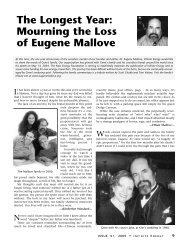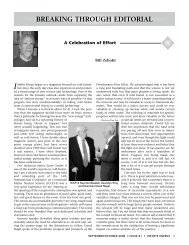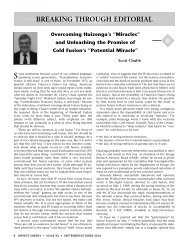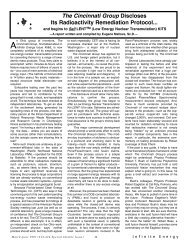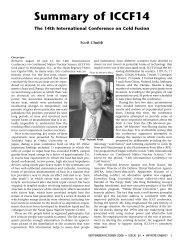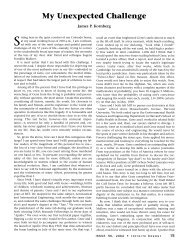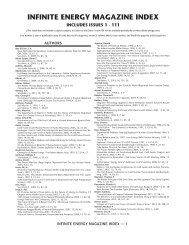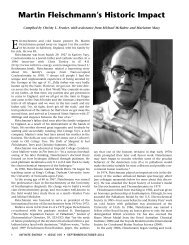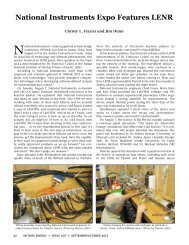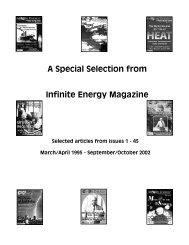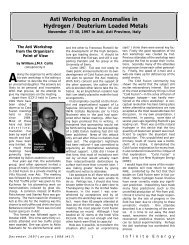MIT and Cold Fusion: A Special Report - Infinite Energy Magazine
MIT and Cold Fusion: A Special Report - Infinite Energy Magazine
MIT and Cold Fusion: A Special Report - Infinite Energy Magazine
Create successful ePaper yourself
Turn your PDF publications into a flip-book with our unique Google optimized e-Paper software.
processed data at the seminar at the Plasma <strong>Fusion</strong> Center on June 7,<br />
1991, Professor Parker publicly said, “We will give you every piece of<br />
data we ever took.” So on June 14, 1991 I submitted a request to Professor<br />
Parker for various data items that would help me clarify the issue<br />
(Attachment #10). Another scientific colleague, Dr. Mitchell R. Swartz,<br />
independently had made several phone calls to Professor Parker, in<br />
which messages were left about requests for the data that Swartz had<br />
heard Parker on June 7 offer to make available.<br />
Not having received any communication from Parker regarding my<br />
June 14 request, I submitted a reminder letter on July 30, 1991 (Attachment<br />
#11). There was no response to this letter either. Nor were any of<br />
Dr. Swartz’s calls returned by Professor Parker. The first response from<br />
Professor Parker came in a faxed letter to me (Attachment #6) on the<br />
evening before a WBUR radio program about cold fusion, in which<br />
Parker <strong>and</strong> I were both pre-recorded participants. In this letter, he continued<br />
to put obstacles in the way of getting the light water heater<br />
power curve. None of the other data requests of June 14, 1991 were even<br />
alluded to. In this letter he claims that Dr. Luckhardt “has been extremely<br />
forthcoming in discussing them with you <strong>and</strong> would be willing to<br />
assist you further.” He wrote, “However, he has major responsibility for<br />
several PFC projects <strong>and</strong> I cannot allow him to take time away from<br />
them for this purpose. I suggest that you negotiate directly with him to<br />
see what arrangements could be made.”<br />
Finally, to cap this absurd one-year history of evasion at every turn,<br />
I received yet another fax letter from Professor Parker on August 13<br />
(Attachment #12), in which inexplicably there has been some time for Dr.<br />
Luckhardt to generate (or simply retrieve from his files) the light water<br />
heater power curve. But the letter suggests that the accompanying<br />
curves (both heavy water <strong>and</strong> light water) “should not be reproduced or<br />
disseminated without our permission.” This statement is put forth even<br />
though the heavy water heater power curve was already published by<br />
the <strong>MIT</strong> group! For reasons unknown to me, Professor Parker wants the<br />
light water power curve to remain out of the public domain.<br />
I think that it is absolutely clear that there has been an unwarranted<br />
withholding of data by the <strong>MIT</strong> group from people with a legitimate<br />
need to access it. In fact, this withholding of data was the turning point<br />
that prompted this request for an inquiry. I had considered making the<br />
request earlier, but was very reluctant to make it. However, the final<br />
evasions raised even greater suspicions in my mind about the nature of<br />
this data <strong>and</strong> how it was h<strong>and</strong>led.<br />
7. Attacks on the Motives of Scientists Who Were Making Positive<br />
Claims About <strong>Cold</strong> <strong>Fusion</strong><br />
The method of performance, representation, <strong>and</strong> access to the <strong>MIT</strong><br />
team’s research is the central issue of this request for an inquiry <strong>and</strong><br />
investigation. However, the <strong>MIT</strong> group’s work did not occur in an intellectual<br />
vacuum. It is impossible to dissociate from the <strong>MIT</strong> group’s performance<br />
the unethical behavior of some of the key organizers of that<br />
research in view of their attacks on the motives of Professors Pons <strong>and</strong><br />
Fleischmann, whose work they apparently wished to discredit with<br />
their own results. This raises questions about the integrity with which<br />
the <strong>MIT</strong> group’s work was carried out.<br />
On May 1, 1989, the <strong>MIT</strong> News Office issued a press release (see<br />
Attachment #13) that was prepared by me in telephone consultation<br />
with Professor Parker of the Plasma <strong>Fusion</strong> Center in the early morning<br />
hours of May 1, 1989. The press release was crafted to deny statements<br />
that Boston Herald reporter Nick Tate had attributed to Professor Parker,<br />
which attacked Professors Pons <strong>and</strong> Fleischmann in the manner denied<br />
in the press release. When I prepared that release, <strong>and</strong> for more than a<br />
year afterward, I believed that the statement that the <strong>MIT</strong> News Office<br />
had issued was valid, though I had some doubts. I simply trusted what<br />
was being asked of me in preparing the release.<br />
After having listened to the actual tape of the interview that Nick<br />
Tate played for me in July 1990, I am certain that his story’s characterization<br />
of what Professor Parker <strong>and</strong> Professor Ballinger had said in<br />
their conversation with Tate the week before is substantially correct.<br />
Professor Parker <strong>and</strong> Ballinger clearly were conducting a well-orchestrated<br />
attempt to condemn the work of Pons <strong>and</strong> Fleischmann, not<br />
merely to criticize it technically. In the taped interview, a copy of which<br />
I obtained from Nick Tate in February 1991 (a partial transcript of which<br />
appears in Attachment #14), Professor Parker used the word “fraud” no<br />
less than five times <strong>and</strong> he does refer to the work of Pons <strong>and</strong> Fleischmann<br />
as “scientific schlock,” despite his subsequent <strong>and</strong> continuing<br />
denials. At one point in the interview Professor Parker says to Nick Tate,<br />
“..what you’re hearing is that we think its a scam, right?” In my view,<br />
virtually any other competent reporter would have written essentially<br />
the same story that Tate wrote. In fact, the partial transcript published<br />
by the Herald on May 2, 1989, should have been enough to convince me<br />
of the soundness of Tate’s story, had I not been told by Professor Parker<br />
that these remarks were “out of context,” <strong>and</strong> that reporter Tate was a<br />
“viper.”<br />
Professor Parker deceived me <strong>and</strong> other members of the <strong>MIT</strong> News<br />
Office about what he had said, then in a press conference on May 1, 1989<br />
he deceived the world about what he had said, <strong>and</strong> he continues to<br />
deceive the world again <strong>and</strong> again (see transcript of recent WBUR radio<br />
program, Attachment #15).<br />
Remarkably, Professor Parker apparently deceived even former<br />
<strong>MIT</strong> President Paul Gray about the nature of his effort to manipulate the<br />
News Media. An April 17, 1989 letter from Boston Globe <strong>Report</strong>er<br />
Richard Saltus to President Gray (see Attachment #16) had complained<br />
about the lack of access to Professor Parker. President Gray’s letter of<br />
response to Richard Saltus on May 1, 1989 (Attachment #17) says, “He<br />
[Parker] has tried to be as helpful as possible, consistent with his belief<br />
that judgement should be reserved until the scientific facts are clarified.<br />
That cautious stance has led him to discourage all media visits to the<br />
Plasma <strong>Fusion</strong> Center, although his efforts have not always been successful.<br />
I have been assured that there was no discrimination against the<br />
Boston Globe <strong>and</strong> that, to the contrary, Professor Parker spoke five or six<br />
times with your colleague, Mr. David Ch<strong>and</strong>ler.”<br />
The truth about Professor Parker’s media manipulation is clear<br />
from this interview with Nick Tate. At one point Parker says, “The reason<br />
I stopped talking to the Globe for example is that I felt that they were<br />
reporting irresponsibly...they were out there just leading the cheers<br />
instead of being objective.” Then later, “. . .you know I can’t trust the<br />
Globe, I’d like to trust you.”<br />
This deception <strong>and</strong> compounded deception about what was said <strong>and</strong><br />
how it was arranged to be said to Nick Tate amounted to a direct attack<br />
on the integrity of an honest reporter as well as the contrived involvement<br />
of a number of <strong>MIT</strong> personnel, including the former President, in<br />
that deception. But as important or more so was the effect that the intended<br />
disparagement of Professor Pons <strong>and</strong> Fleischmann’s work had on the<br />
future course of cold fusion research. The work was difficult enough to<br />
assess without imputing the motive of possible fraud, which allegation at<br />
that time <strong>and</strong> to the present day remains completely unfounded.<br />
Professor Parker was not the only member of the <strong>MIT</strong> research team<br />
to bring up allegations of fraud about Professors Pons <strong>and</strong> Fleischmann.<br />
I am aware of at least two other authors of the <strong>MIT</strong> research paper who<br />
have made such allegations publicly <strong>and</strong> privately.<br />
I hope you will determine that the concerns I have raised about the<br />
conduct of the <strong>MIT</strong> group’s work merit a prompt investigation. If carried<br />
out objectively, such an investigation will, I am very confident,<br />
reveal various levels of scientific misconduct.<br />
To conclude this formal request, I would like to make clear my<br />
belief that however the data from the Phase-II calorimetry experiment<br />
are interpreted, it is clear that it is impossible to use the raw data behind<br />
these flawed results or the data of the cruder series discussed earlier in<br />
the PFC paper to conclusively prove anything one way or another about<br />
the reality of cold fusion. I do not believe that any member of the <strong>MIT</strong><br />
research group ever actually believed it had discovered evidence for<br />
cold fusion <strong>and</strong> then “covered it up.” However, I do firmly believe that<br />
they mish<strong>and</strong>led their data in a manner calculated not to leave any<br />
room for doubt about the finality of their conclusions, when in fact there<br />
was considerable room for such doubt. In my view, the data in this work<br />
were not only improperly manipulated to emphasize an allegedly negative<br />
result, but the significance of conclusions about that data were <strong>and</strong><br />
continue to be misrepresented <strong>and</strong> confused.<br />
Even if this work had been done properly <strong>and</strong> offered a clear null<br />
result, it would still have been far too limited a check. Other laboratories<br />
that have obtained sporadic positive results for excess power—<strong>and</strong> by<br />
now even reproducible excess power (SRI, Inc. in Palo Alto under EPRI<br />
contract)—have generally spent much more time in their trials <strong>and</strong><br />
employed a larger series of electrodes, a possible requirement sometimes<br />
to pick up the anomalous thermal effects. The body of evidence in support<br />
of some if not all cold fusion claims, in fact continues to grow, as can<br />
44 <strong>Infinite</strong> <strong>Energy</strong> • ISSUE 24, 1999 • <strong>MIT</strong> <strong>Special</strong> <strong>Report</strong>



